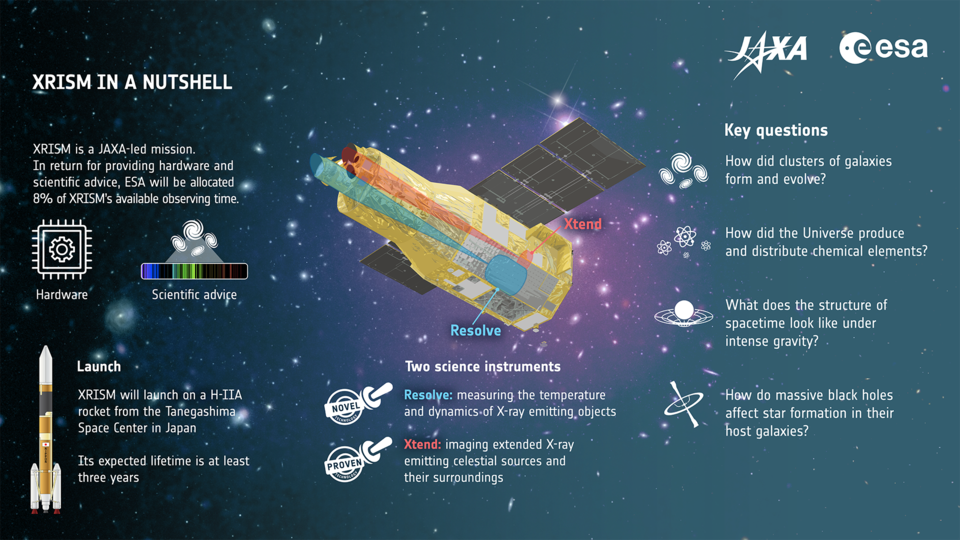XRISM unveils black hole and supernova remnant surroundings
XRISM revealed the structure, motion and temperature of the material around a supermassive black hole and in a supernova remnant in unprecedented detail. Astronomers presented the first scientific results of the new X-ray telescope today, less than a year after the telescope’s launch.
What do a gigantic black hole and the remains of a massive, exploded star have in common? These are both dramatic celestial phenomena where extremely hot gas produces highly energetic X-ray light that the X-Ray Imaging and Spectroscopy Mission (XRISM) can see.
In its first published results, XRISM, a mission led by the Japan Aerospace Exploration Agency (JAXA) with participation from ESA, shows its unique capabilities to reveal the speed and temperature of sizzling hot gas, called plasma, and the three-dimensional structures of material surrounding a black hole and an exploded star.
“These new observations provide crucial information in understanding how black holes grow by capturing surrounding matter, and offer a new insight into the life and death of massive stars. They showcase the mission’s exceptional capability in exploring the high-energy Universe,” says ESA XRISM Project Scientist Matteo Guainazzi.
Supernova remnant N132D
In one of its "first light" observations, XRISM focused on N132D, a supernova remnant located in the Large Magellanic Cloud about 160 000 light-years from Earth. This interstellar ‘bubble’ of hot gas was expelled by the explosion of a very massive star approximately 3000 years ago.
Using its Resolve instrument, XRISM uncovered the structure around N132D in detail. Contrary to prior assumptions of a simple spherical shell, scientists found out that the remnant of N132D is shaped like a doughnut. Using the Doppler effect, they measured the speed (velocity) at which the hot plasma in the remnant is moving towards or away from us, and established that this is expanding at the apparent speed of around 1200 km/s

Resolve also revealed that the remnant contains iron that has an extraordinary temperature of 10 billion degrees Kelvin. The iron atoms were heated during the supernova explosion through violent shock waves spreading inwards, a phenomenon that had been predicted by theory, but never observed before.
Supernova remnants like N132D hold important clues into how stars evolve and how (heavy) elements that are essential to our life, like iron, are generated and spread out in interstellar space. Yet, previous X-ray observatories have always had difficulty revealing how the plasma’s velocity and temperature were distributed.
Supermassive black hole in galaxy NGC 4151
XRISM has also shed new light on the mysterious structure surrounding a supermassive black hole. Focusing on the spiral galaxy NGC 4151, located 62 million light-years away from us, XRISM’s observations offer an unprecedented view of the material very close to the galaxy’s central black hole, which has a mass 30 million times that of the Sun.
XRISM captured the distribution of the matter circling and ultimately falling into the black hole over a wide radius, spanning from 0.001 to 0.1 light-years, that is from about a distance comparable to the Sun–Uranus separation to 100 times that.

By determining the motions of iron atoms from their X-ray signature, scientists mapped out a sequence of structures surrounding the giant black hole: from the disk ‘feeding’ the black hole all the way out to the doughnut-shaped torus.
These findings provide a vital piece of the puzzle in understanding how black holes grow by gobbling up surrounding matter.
Although radio and infrared observations have revealed the presence of a doughnut-shaped torus around black holes in other galaxies, XRISM’s spectroscopic technique is the first, and currently only way to track down how the gas near the central ‘monster’ is shaped and moves.
Looking Ahead: Future Observations and Discoveries
In the last months, the XRISM science team has diligently worked on establishing the instruments’ performance and refine the data analysis methods by observing 60 key targets. In parallel,104 new set of observations were selected from the over 300 proposed submissions from scientists worldwide.
XRISM will conduct observations based on the successful proposals over the next year; thanks to its exceptional performance in orbit, surpassing even initial expectations, this promises many more exciting discoveries to come.
About XRISM

The X-Ray Imaging and Spectroscopy Mission (XRISM) launched on 7 September 2023. It is a collaboration between the Japan Aerospace Exploration Agency (JAXA) and NASA, with significant participation from ESA. In return for providing hardware and scientific advice, ESA is allocated 8% of XRISM’s available observing time.
Observations made using XRISM will complement those from ESA’s XMM-Newton X-ray telescope, and will be an excellent foundation for observations planned with ESA’s future large-class mission NewAthena. The latter is being designed to significantly exceed the scientific performance of existing spectroscopic and survey X-ray observatories.
Notes for editors
These results by the XRISM Collaboration are accepted for publication in the Astronomical Society of Japan and The Astrophysical Journal. Preprints are available here https://arxiv.org/abs/2408.14300 and here https://arxiv.org/abs/2408.14301.
Original release on XRISM website.
Contact:
ESA Media relations
media@esa.int















 Germany
Germany
 Austria
Austria
 Belgium
Belgium
 Denmark
Denmark
 Spain
Spain
 Estonia
Estonia
 Finland
Finland
 France
France
 Greece
Greece
 Hungary
Hungary
 Ireland
Ireland
 Italy
Italy
 Luxembourg
Luxembourg
 Norway
Norway
 The Netherlands
The Netherlands
 Poland
Poland
 Portugal
Portugal
 Czechia
Czechia
 Romania
Romania
 United Kingdom
United Kingdom
 Slovenia
Slovenia
 Sweden
Sweden
 Switzerland
Switzerland



























